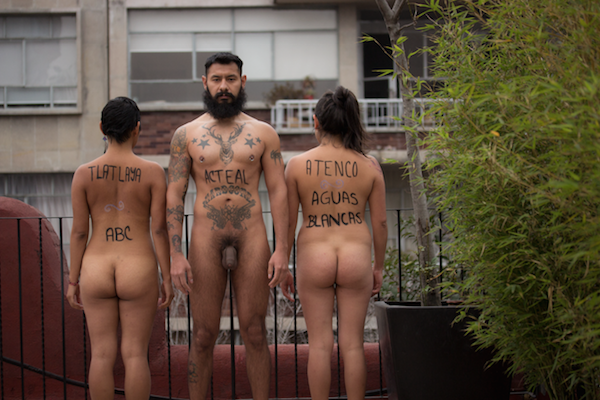Art World
Naked Youths Take to Mexican Streets to Protest Student Killings Documented by Édgar Olguín
Photographer Édgar Olguín's project is turning heads across the capital.
Photographer Édgar Olguín's project is turning heads across the capital.
Lorena Muñoz-Alonso

The photographer Édgar Olguín has responded to the mass kidnapping and presumed killing of 43 students in the Mexican state of Guerrero with a powerful photographic series.
The project, Poner el cuerpo: sacar la voz (which roughly translates as “to show one’s body, to raise one’s voice”), is comprised of 14 photographs of young men and woman in the nude in public spaces across Mexico City, including public buses, subway carriages, desolate streets, and bridges.
Their naked bodies have been painted with a series of protest slogans and hashtags—chanted and shared by many in the aftermath of the tragedy—including “It was the army,” “State Murderer,” “Four Months of Impunity,” “#I’vehadenough,” and “We keep fighting 43.”
The messages allude to the events that took place on the night of September 26, 2014, when a group of over 100 students from the Raúl Isidro Burgos school in Ayotzinapa marched towards the historical city of Iguala to protest against the local government’s hiring and funding practices, which they considered discriminatory. The all-male teacher training college has a marked left-wing bias and a long association with student activism.
The students’ plan was to disrupt the annual conference of the National System for Integral Family Development, which was being held in Iguala by the local president of the organization, María de los Ángeles Pineda Villa, wife of the mayor of Iguala, Jose Luis Abarca. But the students were intercepted by municipal police before they got to their destination.
Versions of the events that followed vary depending on the sources. According to police reports, the students had hijacked three buses, which the police chased and opened fire on. (The student union says the students were only hitchhiking.) Six people were killed and 25 wounded during the chase. A group of students escaped and reconvened on the scene to speak to reporters. It was then when they were seized by police and hauled into police vehicles, never to be seen again.

From the Poner el cuerpo: sacar la voz series (2014–15), by Édgar Olguín
Last November, BBC reported that three members of a crime gang, arrested in connection to the disappearance, had confessed to killing more than 40 students, which, they claimed, had been handed over to them by the municipal police. They shot the students, some of whom they thought belonged to a rival gang, and burned their bodies at a rubbish dump near Cocula. Last week, Mexican authorities concluded that the missing 43 students had been murdered.
Up 70 people have been arrested in connection to the case. Sixteen police officers are currently imprisoned under aggravated murder charges. The mayor of Iguala and his wife were also arrested last November, after fleeing the city and going into hiding for weeks.
The case shocked Mexico and the international community, with countless tokens and demonstrations of outrage and consternation against what’s seen by many as a collusion between officials and organized crime.
As with other recent tragedies, such as the Charlie Hebdo killings and the Ferguson shootings, artists have been swift and keen to respond (see Why the Killing of Charlie Hebdo Cartoonists Will Make Art Stronger, #JeSuisCharlie: A Digest of Responses to the Killings at Charlie Hebdo, Days Before the Verdict, Artist Reclaimed Ferguson’s Boarded-Up Shops and After Ferguson, A New Protest Culture’s Challenge to Art).
Olguín began working on Poner el cuerpo: sacar la voz shortly after the students’ disappearance, even before their tragic fate had been discovered. The naked body, understood as a symbol of unity and sincerity, was paramount to the project from the onset. “In contemporary society, a naked body has become a more alarming sight than a burned cadaver on a front page,” Olguín told La Jornada.
The artist spoke of the insults and sideway glances that he and his subjects received while in the process of taking the photographs but also of the signs of support and encouragement expressed by numerous passers-by.
Olguín released his series through a Tumblr page, in the last week of January, coinciding with the four-month anniversary of the massacre. “From the very beginning, our aim was to exhibit the project in the largest gallery of the world: the Internet,” Olguín explained. “We did not want to commodify this project.”

From the Poner el cuerpo: sacar la voz series (2014-2015), by Édgar Olguín